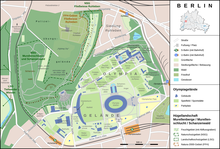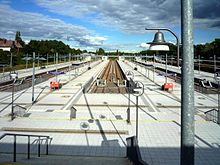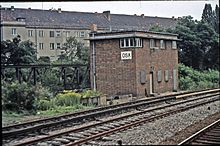Berlin Olympiastadion train station
| Berlin Olympic Stadium | |
|---|---|
|
Reception building
|
|
| Data | |
| Location in the network | Intermediate station |
| Design | Riding station |
| Platform tracks | 10 |
| abbreviation | BOLS |
| IBNR | 8089330 |
| Price range | 3 |
| opening | May 23, 1909 January 16, 1998 |
| Conveyance | September 19, 1980 |
| Website URL | s-bahn-berlin.de |
| Profile on Bahnhof.de | Olympic Stadium |
| Architectural data | |
| architect |
Ernst Schwartz , Dörgé (1909) Fritz Hane (1936) |
| location | |
| City / municipality | Berlin |
| Place / district | West end |
| country | Berlin |
| Country | Germany |
| Coordinates | 52 ° 30 '40 " N , 13 ° 14' 30" E |
| Railway lines | |
|
Spandau suburban railway (km 16.2) |
|
| Railway stations in Berlin | |
The Berlin Olympiastadion train station is a train station in the Westend district of Berlin . It consists of a suburban station, which is regularly served by the trains of the Berlin S-Bahn , as well as a terminus station for special trains at events in the nearby Olympic Stadium . At the opening of the racecourse Grunewald railway station was in May 1909 under the name racetrack in operation and was at the 1936 Summer Olympics rebuilt comprehensively. Between 1980 and 1998 the traffic on the suburban railway was idle.
Location and structure

The station is located on the southern edge of the Olympic site at the 16.2 kilometer of the suburban railway from Westkreuz to Spandau . The facility has five platforms with a total of ten tracks, entrances and exits are on Flatowallee at the western end of the platforms and at mid-height of the platforms to the north of Trakehner Allee. The southernmost platform is used for regular S-Bahn traffic, the other four head platforms are used for events. The reception building is on Flatowallee at the level of the suburban platform.
The entire system is part of the overall Spandauer Vorortbahn system and is listed as such in the Berlin State Monument List.
history
With the opening of the station, the first section of the Spandau suburban railway went into operation. The suburban railway was supposed to cope with the steadily increasing traffic between the cities of Charlottenburg and Spandau and at the same time serve newly developed terrain. One of the residents was the Union-Klub , which built a racecourse in the northern part of the Grunewald and needed a transport connection.
At first only the racing station was built. This comprised eight platform tracks on five platforms (two side, three central platforms) as well as bypass tracks in between and a two-storey station building that was kept in the Nordic style. The northern platform F was also intended for the loading of horses from the nearby racetrack, so there was a ramp here in addition to the staircase. During the construction work there was a siding to the existing long-distance line Charlottenburg – Spandau as well as a narrow-gauge material railway to Stößensee , where work on the construction of the Döberitz Heerstraße including the Freybrücke and Stößenseebrücke was in progress.

The Rennbahn train station opened on May 23, 1909. On the same day, the Grunewald racecourse was inaugurated in the presence of Kaiser Wilhelm II . The traffic was initially limited to special trains on race days. On September 5, 1911, the southern suburban platform A went into operation together with the entire line. To the west of the platform ends, this was given a sweeping system to allow trains to end at smaller events without putting the racing station into operation.
On August 23, 1928, the station was connected to the suburban electrical network, from which the Berlin S-Bahn emerged in 1930. On May 15, 1930, the name was changed to Stadion - Rennbahn Grunewald to refer to the Grunewaldstadion , which was created in 1913 within the racetrack.
With the award of the Olympic Games to the capital of the Reich, the site was converted into the Reichssportfeld, today's Olympic site. For this purpose, the station was renamed Reichssportfeld on May 1, 1935 and expanded during this period according to plans by Fritz Hane . The reception building gave way to an open hall that seemed more suitable for handling the flow of visitors. In addition, the pedestrian bridge with the Trakehner Allee exit went into operation. Furthermore, the Deutsche Reichsbahn built an electromechanical signal box - Rsa later Osa (Olympic Stadium junction) - near the neighboring Heerstraße train station and automatic track vacancy detection systems. The capacity was increased to 48,000 visitors per hour.
During the Second World War , as the front drew closer, there were repeated operational restrictions. Traffic was completely idle between April 27, 1945 and June 9, 1945.
On May 29, 1960, the Deutsche Reichsbahn renamed the station the Olympiastadion . About a year later, the West Berlin Senate called for a boycott of the S-Bahn operated by the Deutsche Reichsbahn on the occasion of the construction of the Wall . As in large parts of the network, traffic at the Olympiastadion station then fell dramatically. Nevertheless, the Deutsche Reichsbahn used trains to the special station at various events. In addition to the league games from Hertha BSC , these included the games of the 1974 World Cup and the German Evangelical Church Congress in 1977.
After the Reichsbahn strike in 1980 , the Reichsbahn stopped traffic on the Spandau suburban railway on September 19, 1980. After the operating rights were handed over to the Berliner Verkehrsbetriebe at the beginning of 1984, the latter and the Senate intended to reopen the route. The work on this took place in the 1990s.
For the reconstruction, large parts of the facility were removed and rebuilt, including all platforms and the pedestrian bridge to Trakehner Allee. The special platform F was given up. On January 16, 1998, with the reopening of the Westkreuz – Pichelsberg section, suburban platform A and special platform B, now with two platform edges, went into operation. The remaining five platforms followed on the occasion of the 75th anniversary of the S-Bahn on May 29, 1999. Since then, the event station has a capacity of 40,000 passengers an hour. A sold out Olympic stadium could thus be "emptied" in less than two hours.
Contrary to the standard ZAT dispatching procedure, trains are dispatched on the special platforms by a local supervisor .
traffic
The station is currently served by the S3 and S9 lines of the S-Bahn Berlin, there is a possibility to change to various bus lines of the Berlin transport company. From 1936 to 1966 there was also a connection to the Berlin tram network , which was used almost exclusively at events.
| line | course |
|---|---|
|
|
Spandau - Stresow - Pichelsberg - Olympiastadion - Heerstraße - Messe Süd - Westkreuz - Charlottenburg - Savignyplatz - Zoological Garden - Tiergarten - Bellevue - Central Station - Friedrichstraße - Hackescher Markt - Alexanderplatz - Jannowitzbrücke - Ostbahnhof - Warschauer Straße - Ostkreuz - Rummelsburg - Rummelsburg depot - Karlshorst - Wuhlheide - Köpenick - Hirschgarten - Friedrichshagen - Rahnsdorf - Wilhelmshagen - Erkner |
|
|
Spandau - Stresow - Pichelsberg - Olympiastadion - Heerstraße - Messe Süd - Westkreuz - Charlottenburg - Savignyplatz - Zoological Garden - Tiergarten - Bellevue - Hauptbahnhof - Friedrichstraße - Hackescher Markt - Alexanderplatz - Jannowitzbrücke - Ostbahnhof - Warschauer Straße - Treptower Park - Plänterwald - Baumschulenweg - Schöneweide - Schöneweide depot - Adlershof - Altglienicke - Grünbergallee - Berlin-Schönefeld Airport |
literature
- Erich Giese: The new Rennbahn station in Grunewald near Berlin and the creation of special suburban tracks between Heerstrasse station and Spandau . In: Zentralblatt der Bauverwaltung , vol. 30 (1910), pp. 537-542, 553-557. Digitized
- Ernst Hane: Reconstruction and expansion of the buildings at the Reichssportfeld, Pichelsberg and Deutschlandhalle S-Bahn stations in Berlin . In: Zentralblatt der Bauverwaltung , vol. 57 (1937), pp. 812–818. Digitized
Web links
- Entry in the Berlin State Monument List
- Mike Straschewski: Olympic Stadium. In: stadtschnellbahn-berlin.de. May 22, 2009. Retrieved May 19, 2012 .
Individual evidence
- ↑ Station price list 2020. In: Deutsche Bahn. Deutsche Bahn, January 1, 2020, accessed on July 11, 2020 .
- ↑ Entry in the Berlin State Monument List
- ↑ Otto Sarrazin, Friedrich Schultze: The new Rennbahn station in Grunewald near Berlin and the creation of special suburban tracks between Heerstrasse station and Spandau . In: Zentralblatt der Bauverwaltung . No. 85, October 22, 1910, pp. 553-557 .
- ↑ a b c Mike Straschewski: Olympiastadion. In: stadtschnellbahn-berlin.de. May 22, 2009. Retrieved May 19, 2012 .
- ↑ Manuel Jacob: ZAT now regular handling of the S-Bahn . In: Berliner Verkehrsblätter . No. 6 , 2017, p. 112 f .

